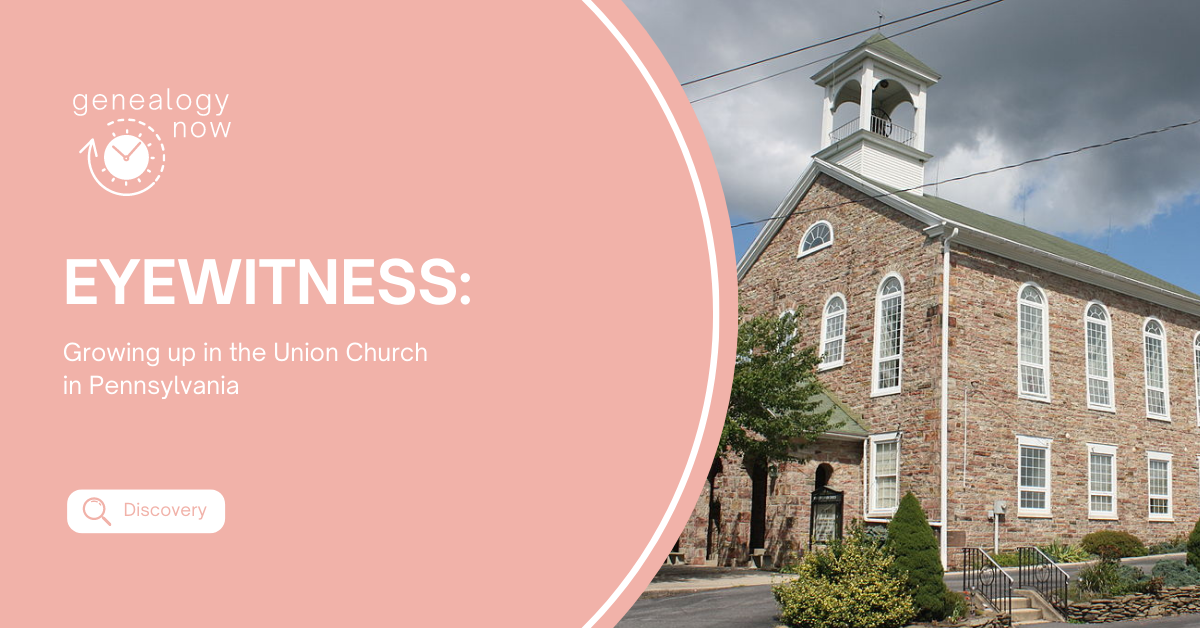
A reader recently stumbled upon an article I wrote in 2019 titled Union Churches in Pennsylvania. He graciously emailed me an account written by his mother, Anna Deppen Lutz, who was born in 1928 and was “baptized, confirmed and married in St. Luke’s Union Church in Malta, Pennsylvania.” It was interesting to read Anna’s description of farm life and her first-hand experience with the cooperation between members of the Lutheran and Reformed faiths in rural southeastern Pennsylvania. With my reader’s permission, I am sharing Anna’s account here. I hope you will find it as fascinating as I did.
If you are interested in learning more about finding church records in Pennsylvania, listen to the latest episode of the Research Like a Pro podcast, where I join Diana and Nicole to discuss probate and church records (episode 210). This episode is part of a series on researching Pennsylvania German ancestors.
The Union Church
by Anna Deppen Lutz (1928-2016)
The Union Church was an institution unique to rural southeast Pennsylvania, born of the poverty and isolation of the early Lutheran and Reformed settlers from Germany and Switzerland. In the Union Churches, two congregations, one Lutheran and one Reformed lived together in one House of Worship….unwed…..but with benefit of two clergy!”
I was baptized, confirmed and married in St. Luke’s Union Church in Malta, Pa. It was a small church, with less than 80 Reformed members and perhaps 100 Lutheran members.
The area that I think of as “home” extends from the Susquehanna River northeast-ward toward the Coal Region – perhaps 30 miles east and 20 miles wide – north to south, and includes Sunbury, the county seat of Northumberland County. It also includes such towns as Gratz, Hebe, Valley View and Leck Kill. These towns are very, very small.
Our farm was small, even for a family farm, so it was necessary to make complete use of the farm, and we had a varied agenda for farming: a small herd of 10 to 12 dairy cows, a dozen pigs and fields of wheat, oats, corn and pasture. Farmers in this situation could not afford help, so that a day away from the farm was impossible, as cows need to be milked twice a day.
The church was the real center of the community. It was one of four in a Charge served by two pastors, one Lutheran and one Reformed, who on alternate Sundays conducted Lutheran Services in two churches and Reformed in the other two.
I cannot remember even one family who came to Church only every other week when “their pastor” did the Service. I think my family’s rule were common: Unless you were so sick you fell over as you walked to the car, YOU WENT TO CHURCH!
In many ways the Union Church was a good way of shared religious life. The Lutheran Pastor always used the Lutheran Liturgy. None of the Reformed Pastors I knew were “dyed in the wool Mercersburg theologians” and the Reformed Services were less formal, except for Holy Communion , when we used every last phrase and line of the Liturgy, including the Nicene, never the Apostles’ Creed. Of course, we all knew the Apostles’ Creed (the Lutheran Version) because it was used regularly every other Sunday in the Lutheran Liturgy.
We alternated the use of Lutheran and Reformed Church School curriculum. Since there were four congregations in the Charge, the Pastors also alternated years for Confirmation. Both Pastors always had the Confirmands publically recite answers from their respective Catechisms before the Rite of Confirmation.
It was only on Communion Sundays that anyone could be sure who belonged to which congregation. The Lutheran Pastor always included an admonition: “This Communion is for members of the Lutheran Church only.”
When the Reformed Pastors conducted Communion, they always made a point of proclaiming, “This Table is open to anyone who believes in Jesus Christ and is a member of any Church.” I sometimes knew Reformed congregation knew we needed the Lutheran interest, support and money to keep the Church going.
But, it just happened that most of the musical talent in the combined congregation belonged to the Reformed congregation. The Lutheran organist readily admitted that without the Reformed members of the choir, they could not have gotten through the relatively complicated Lutheran Communion Liturgy. And, yes, there were two organists!
I think most of the Union Church people truly believed they were all going to the same place. I have never heard of a Union Church in Pennsylvania that had two cemeteries!
